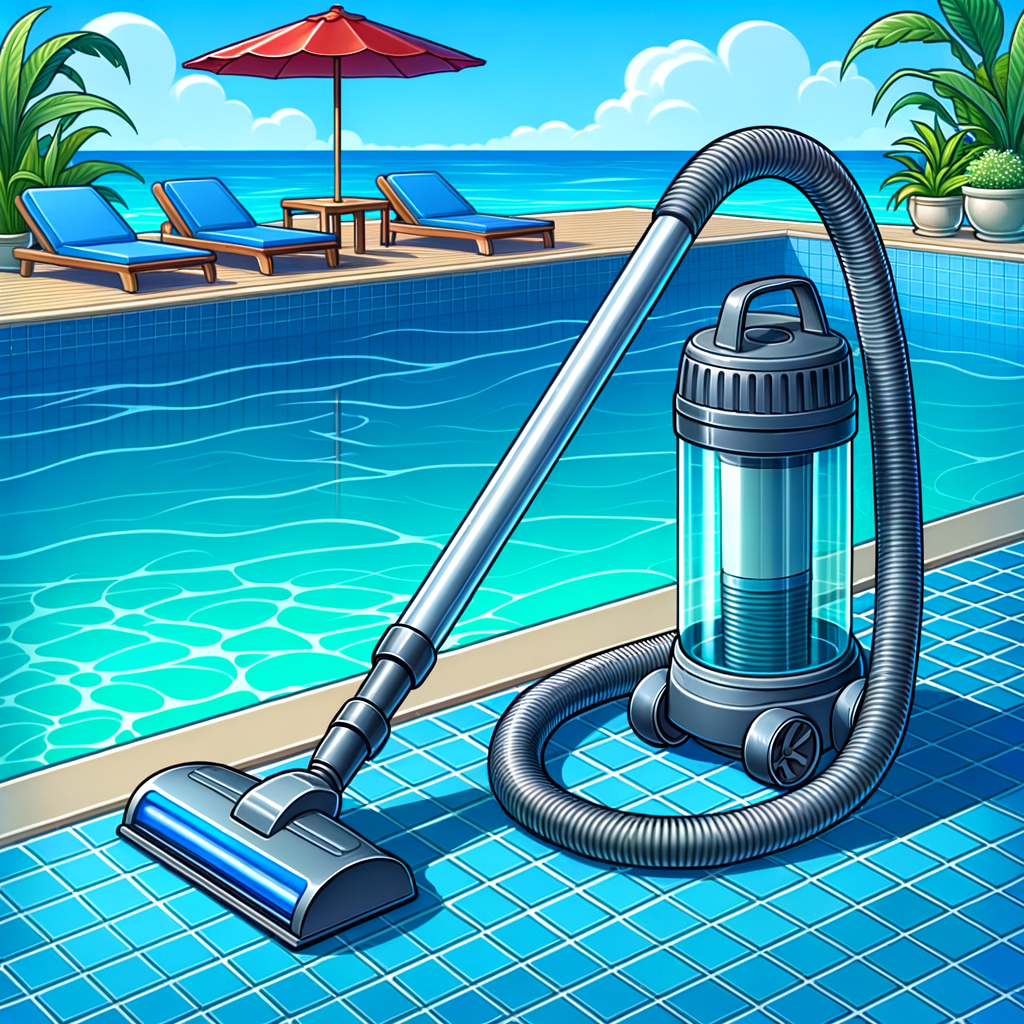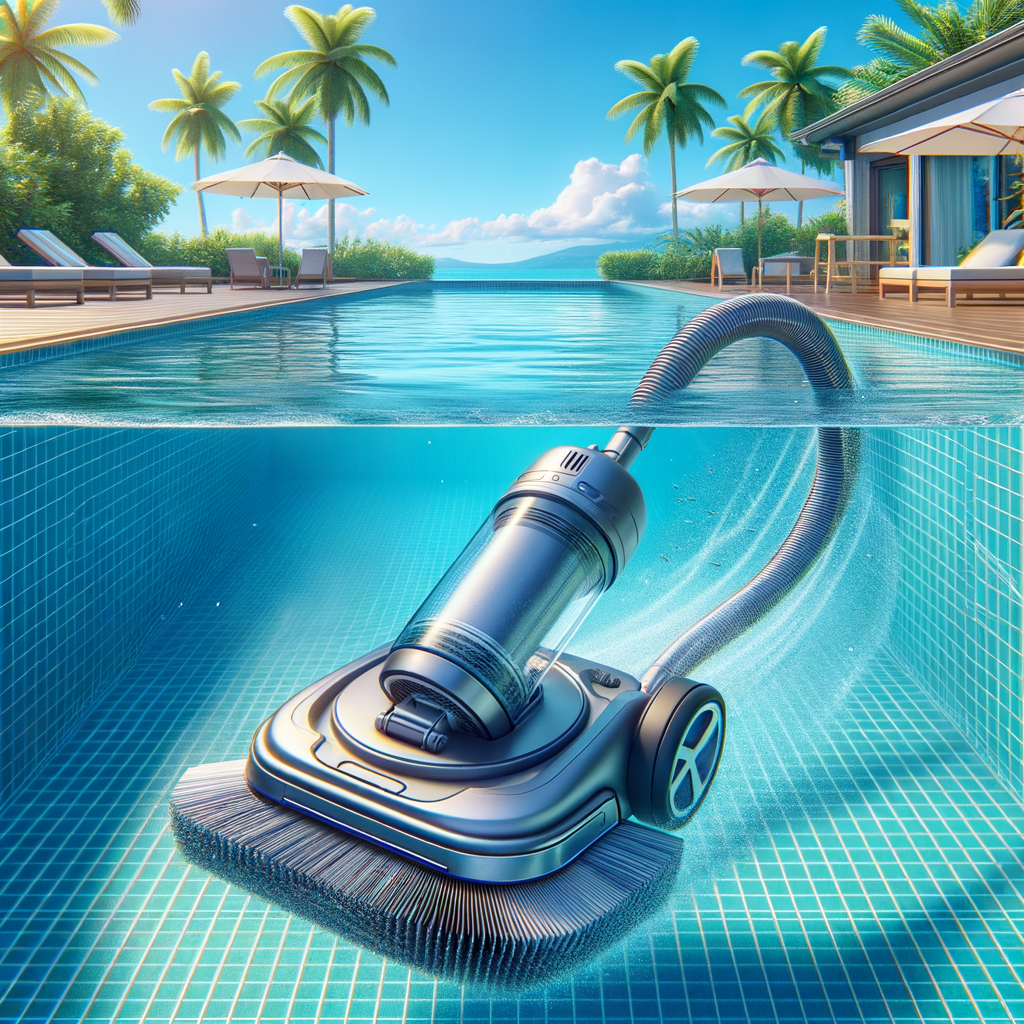
“Effortlessly Clean, Blissfully Serene: Experience the Ultimate pool vacuum.”
Table of Contents
Introduction
A pool vacuum is an essential tool designed to maintain the cleanliness of swimming pools by removing debris, dirt, and algae from the water. This device operates either manually or automatically, ensuring that the pool remains hygienic and visually appealing. Manual pool vacuums require physical effort as they are typically attached to a telescopic pole and require the user to move them around the pool.
Automatic pool vacuums, on the other hand, function independently, with some models using suction power from the pool’s filtration system, while others are electrically powered and can navigate the pool floor and walls on their own. The use of a pool vacuum not only helps in maintaining the aesthetic appeal of the pool but also contributes to the overall health and safety of the swimming environment by preventing the buildup of harmful contaminants.
Black Friday Deals on Pool Vacuums: What to Look Out For
As Black Friday approaches, shoppers are gearing up for significant discounts on a wide array of products, including pool vacuums. This time of year is ideal for securing great deals on these essential pool cleaning tools, but knowing what to look for can make a substantial difference in both savings and product satisfaction.
Pool vacuums come in various types, including manual, automatic, and robotic models, each suited to different pool sizes and cleaning needs. Manual pool vacuums are the most economical option and are perfect for smaller or less frequently used pools. They require physical effort to operate, as they must be manually moved around the pool.
On the other hand, automatic pool vacuums offer a more convenient cleaning experience. They typically operate off the pool’s existing filtration system and move randomly around the pool, cleaning the floor and sometimes the walls. Robotic pool vacuums, which represent the pinnacle of convenience and technology, operate independently of the pool’s filtration system and are powered by electricity. These devices not only clean the pool’s floor and walls but also filter the water and can be programmed for specific patterns and schedules.
When searching for Black Friday deals on pool vacuums, it’s crucial to consider the specific needs of your pool. For instance, if you have a large pool or one that collects a lot of debris, a robotic pool vacuum might be the most efficient choice. These models are typically more expensive, but Black Friday sales can make them more affordable. It’s also important to look at the features offered by different models. Some vacuums have advanced capabilities like remote controls, programmable timers, and even smartphone connectivity for ease of use.
Moreover, durability and ease of maintenance are important factors to consider. Pool vacuums should have a robust design to handle pool vacuum regular exposure to pool chemicals and UV light. Additionally, easy access to replaceable parts and straightforward cleaning procedures will make maintenance less of a chore and extend the life of the vacuum.
Retailers often offer deep discounts on older models during Black Friday to clear out inventory, which can be a fantastic opportunity to snag a high-quality product at a fraction of the cost. However, it’s essential to research and compare the features of older models with the latest ones. Sometimes, the newer models have significant improvements or energy efficiencies that justify the extra expense.
Lastly, while price is a significant factor during Black Friday sales, it’s also wise to consider the warranty and customer service support offered by the manufacturer. A good warranty can protect your investment, while excellent customer service can resolve any issues that might arise during the product’s lifespan.
In conclusion, Black Friday presents an opportune moment to invest in a pool vacuum. By carefully considering the type of vacuum that best suits your needs, examining the features and durability of available models, and taking into account the after-sales support, you can make an informed decision that ensures value for money and keeps your pool pristine with minimal effort.
Comparing Cordless Pool Vacuum Options: Which Is Best for You?

When it comes to maintaining a clean and inviting swimming pool, having the right equipment is crucial. Among the various tools at a pool owner’s disposal, the pool vacuum stands out for its efficiency in removing debris and dirt. In recent years, cordless pool vacuums have gained popularity due to their convenience and ease of use. As you consider which cordless pool vacuum is best for you, it’s important to compare the available options based on several key factors including suction power, battery life, usability, and overall value.
Cordless pool vacuums offer significant advantages over their corded counterparts, primarily in terms of mobility and ease of use. Without the need to manage a long cord, users can move freely around the pool, making it easier to reach all areas without any hassle. This is particularly beneficial for larger pools or those with complex shapes and numerous corners. However, the performance of cordless models can vary greatly, so understanding their capabilities is essential.
One of the first aspects to consider when comparing cordless pool vacuums is suction power. This determines how effectively the vacuum can pick up debris, ranging from fine particles like sand to larger leaves and twigs. Higher suction power generally results in a cleaner pool with less effort, but it can also impact battery life. Some of the leading models on the market balance these needs effectively, offering powerful suction while still maintaining a reasonable runtime.
For a more detailed review of the YouSky Handheld Pool Vacuum, visit Pools Depot.
Battery life is another critical factor. Most cordless pool vacuums are powered by rechargeable batteries, and the duration for which they can operate on a single charge varies widely. Typically, you can expect anywhere from 30 minutes to several hours of vacuuming time, depending on the model and the intensity of the suction setting. For larger pools, or for those who prefer to do a thorough cleaning less frequently, opting for a vacuum with a longer battery life might be more convenient.
Usability is also a key consideration. Features such as lightweight design, easy-to-empty debris chambers, and user-friendly controls can make the pool cleaning process much more manageable. Some models also come with additional attachments or features, such as brushes or wheels, which can enhance cleaning efficiency and protect the pool’s lining from scratches.
Finally, overall value should not be overlooked. While it might be tempting to go for the cheapest option, investing in a more robust model from a reputable brand often pays off in the long run. These vacuums not only tend to last longer but also perform better, which means more consistent cleaning results and fewer replacements or repairs.
In conclusion, choosing the right cordless pool vacuum depends on a careful evaluation of your specific needs and preferences. Consider the size and shape of your pool, the typical amount and type of debris, and how frequently you plan to use the vacuum. By balancing factors such as suction power, battery life, usability, and overall value, you can select a model that not only makes pool maintenance easier but also enhances your overall pool ownership experience. Remember, a clean pool is not only more visually appealing but also safer and more enjoyable to use.
How to Effectively Use a Pool Vacuum for Algae Removal
Algae growth in swimming pools can be a persistent issue, detracting from the visual appeal and hygiene of the pool. To effectively combat this problem, using a pool vacuum is a highly recommended solution. This article will guide you through the process of using a pool vacuum to remove algae, ensuring your pool remains clean and inviting.
The first step in the process is to ensure that your pool’s chemical balance is properly maintained. Algae thrive in pools with imbalanced pH levels, so it is crucial to test the water and adjust the chemicals accordingly. Once the water chemistry is balanced, the environment becomes less hospitable to algae, making the physical removal process more effective.
Before you start vacuuming, it is advisable to brush the walls and floor of the pool. This action helps to dislodge the algae from the surfaces, making it easier for the vacuum to pick them up. Use a pool brush with stiff bristles, paying extra attention to areas that are prone to algae accumulation, such as corners and stairs.
After brushing, you can proceed to set up your pool vacuum. Whether you are using a manual or automatic vacuum, ensure that it is assembled according to the manufacturer’s instructions. For manual vacuums, attach the vacuum head to the telescopic pole and connect the vacuum hose to the head. Submerge the vacuum head into the pool, and then slowly feed the hose into the pool until it is filled with water, which prevents air from entering the pool’s filter system.
Starting at the shallow end of the pool, methodically move the vacuum head across the surface of the pool. It is important to move slowly to allow the vacuum to suction up all the algae and debris. Overlapping your strokes slightly ensures that no areas are missed. For automatic vacuums, simply place the cleaner in the pool and let it run its course, though manual spot checks might be necessary for persistent or dense patches of algae.
Once the vacuuming is complete, it is essential to clean the vacuum filter or bag, as algae and debris can clog the system, reducing its efficiency. Rinse out the filter or replace the bag as needed, depending on the type of vacuum you are using.
After the physical removal of algae, it is beneficial to shock the pool. This process involves adding a large dose of chlorine or another sanitizer to the pool water to kill any remaining algae spores and sanitize the water. Follow the manufacturer’s guidelines for the correct amount of shock to use, and ensure the pool pump is running to circulate the chemicals evenly throughout the pool.
Finally, maintaining regular cleaning and monitoring schedules is crucial in preventing future algae outbreaks. Regular brushing and vacuuming, along with diligent monitoring of water chemistry, can keep your pool clear and algae-free.
In conclusion, effectively using a pool vacuum for algae removal not only enhances the cleanliness and appearance of your pool but also contributes to a healthier swimming environment. By following these steps and maintaining consistent pool care practices, you can enjoy a pristine pool throughout the swimming season.
Top 5 Robotic Pool Cleaners for Fiberglass and Inground Pools
Title: Top 5 Robotic Pool Cleaners for Fiberglass and Inground Pools
Maintaining a clean and inviting pool requires the right tools, especially when dealing with the unique challenges posed by fiberglass and inground pools. Robotic pool cleaners have become a favored choice due to their efficiency and ease of use. These autonomous units operate independently of the pool’s filtration system, using their own power source to move around and clean. This article explores the top five robotic pool cleaners that are particularly effective for fiberglass and inground pools.
Starting with the Dolphin Nautilus CC Plus, this cleaner stands out for its superior cleaning capabilities and user-friendly features. It is designed to efficiently clean pools up to 50 feet in length, making it ideal for most residential pools. The Nautilus CC Plus features CleverClean Technology, a navigation system that ensures no spot is missed. Additionally, its powerful dual scrubbing brushes effectively remove dirt and debris, while the large top-load cartridge filters capture fine and ultra-fine particles.
Transitioning to another excellent option, the Polaris F9550 Sport provides a robust cleaning solution with its four-wheel drive system that allows it to overcome obstacles and uneven surfaces. This model is particularly adept at cleaning tight corners and under pool stairs, areas often missed by other cleaners. It also includes a remote control for spot cleaning, giving pool owners precise control over the cleaning process.
Another noteworthy contender is the Hayward TigerShark QC, which is known for its quick cleaning cycles. Ideal for those who need a fast turnaround, the TigerShark can complete a full cleaning cycle in just 90 minutes. Its onboard smart technology calculates the size of the pool and programs an efficient cleaning pattern, minimizing the time the unit spends in the water and reducing energy consumption.
For those seeking advanced technology, the Aquabot X4 is equipped with an exceptional filtration system capable of filtering down to 2 microns. This level of filtration is particularly beneficial for fiberglass pools, which are prone to developing algae and bacteria. The X4 also boasts a high-capacity filter basket and a powerful motor, making it suitable for pools up to 60 feet in length.
Lastly, the Maytronics Dolphin Premier rounds out the list with its multimedia filtration options, which allow users to customize the filtration level based on the debris type. This feature is particularly useful during different seasons when varying types of debris enter the pool. The Dolphin Premier also features a tangle-free swivel cable and a full pool scanning feature, ensuring thorough cleaning coverage.
In conclusion, selecting the right robotic pool cleaner for a fiberglass or inground pool can significantly reduce the maintenance workload and enhance pool enjoyment. Each of the models mentioned offers unique features that cater to different needs, from rapid cleaning cycles to advanced filtration capabilities. By considering the specific requirements of their pool, owners can invest in a robotic cleaner that provides a pristine pool with minimal effort. Whether prioritizing speed, thoroughness, or filtration quality, there is a robotic pool cleaner designed to meet those needs, ensuring that pool owners can spend more time enjoying their investment and less time maintaining it.
The Ultimate Guide to Choosing the Best Pool Vacuum for Your Needs
Choosing the best pool vacuum for your needs can be a daunting task given the variety of options available on the market. However, understanding the different types of pool vacuums and their specific features can significantly simplify the decision-making process. Whether you own a small above-ground pool or a large in-ground one, selecting the right pool vacuum is crucial for maintaining a clean and inviting swimming environment.
The first step in selecting a pool vacuum is to consider the type of pool you have. Above-ground pools typically require lighter, more flexible vacuums that are easy to maneuver around the soft sides of the pool. In contrast, in-ground pools can accommodate heavier, more robust models that provide powerful suction and durability. Additionally, the size and shape of your pool should influence your choice, as certain vacuums are better suited for cleaning large areas or navigating around complex shapes and obstacles.
Another important factor to consider is the type of debris your pool commonly collects. If your pool is surrounded by trees, for instance, you might find yourself dealing with leaves and larger debris. In such cases, a vacuum with a large debris bag and strong suction power would be ideal. For pools that primarily collect dirt, sand, or smaller particles, a vacuum with fine filtration capabilities would be more appropriate.
There are three main types of pool vacuums: suction-side, pressure-side, and robotic. Suction-side vacuums are the most economical option and work by connecting to your existing pool filtration system. They are effective at picking up medium to fine debris but can put additional strain on your pool’s filter. Pressure-side vacuums, on the other hand, require a separate booster pump and are particularly good at collecting large debris. They also help distribute clean, filtered water around your pool, which can enhance the overall circulation and reduce cleaning time.
Robotic pool vacuums represent the most advanced and convenient option. These self-contained units do not require connection to your pool’s filtration system and are powered by low-voltage electricity. They are equipped with their own filters and can scrub the pool’s floor and walls, removing dirt and algae. Although robotic vacuums are typically the most expensive, their efficiency and ease of use make them a popular choice for many pool owners.
Ease of maintenance is also a critical consideration when choosing a pool vacuum. Look for models that are easy to assemble, disassemble, and clean. A vacuum that is cumbersome to maintain can discourage regular use, undermining the cleanliness of your pool. Additionally, consider the availability of replacement parts and the manufacturer’s warranty, as these can affect the long-term cost and enjoyment of your pool vacuum.
Finally, it is wise to read reviews and seek recommendations from other pool owners. Learning from the experiences of others can provide valuable insights into the performance and reliability of different pool vacuum models. Many online forums and retail websites offer customer reviews that can help you gauge the satisfaction of other users.
In conclusion, selecting the right pool vacuum involves a careful consideration of your pool’s specific needs, the type of debris you need to manage, and the features of different vacuum types. By taking into account these factors, you can ensure that your pool remains a clean, healthy, and enjoyable place for everyone to enjoy.
Q&A
1. What is a pool vacuum?
A pool vacuum is a device used to clean debris and dirt from a swimming pool. It operates by suctioning up dirt from the pool floor and walls.
2. What are the main types of pool vacuums?
The main types of pool vacuums are manual vacuums, automatic vacuums, and robotic vacuums. Manual vacuums require physical effort to move them around the pool, automatic vacuums use the pool’s filtration system to move around, and robotic vacuums are self-contained units that operate independently.
3. How often should you vacuum your pool?
It is recommended to vacuum your pool at least once a week to maintain clean and clear water. However, it may be necessary to vacuum more frequently if the pool is used heavily or if there are nearby trees and plants shedding debris into the pool.
4. Can a pool vacuum be used in any type of pool?
Yes, pool vacuums can be used in various types of pools, including in-ground and above-ground pools. However, the choice of vacuum should be appropriate to the pool’s size, shape, and type of lining to avoid damage and ensure efficient cleaning.
5. What maintenance is required for a pool vacuum?
Maintenance for a pool vacuum includes regularly checking and cleaning the filter bag or canister, inspecting the hoses and connections for leaks or wear, and ensuring that moving parts such as wheels or brushes are not obstructed or worn out. Regular maintenance helps prolong the life of the vacuum and ensures optimal cleaning performance.
Conclusion
A pool vacuum is an essential tool for maintaining the cleanliness and hygiene of swimming pools. It effectively removes debris, dirt, and algae from the pool floor and walls, ensuring a clean and inviting swimming environment. Pool vacuums come in various types, including manual, automatic, and robotic, each catering to different needs and pool sizes. Regular use of a pool vacuum can significantly reduce the need for chemical treatments and can prolong the life of the pool by preventing the buildup of harmful substances. Overall, investing in a good quality pool vacuum is crucial for the upkeep of any pool, promoting a safe and enjoyable swimming experience.

